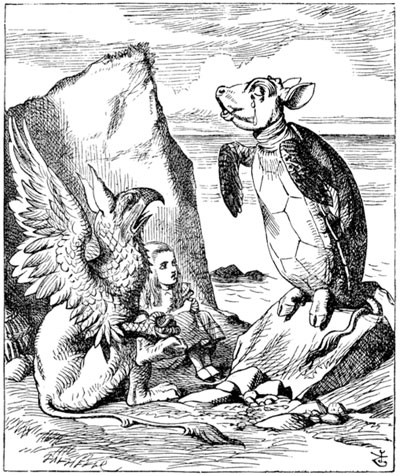A clue to the solution to the shortage of live green turtles for turtle soup is provided in Alice’s Adventures in Wonderland (1865), in which Lewis Carroll’s eponymous heroine is famously introduced to the Mock Turtle by the Queen of Hearts. John Tenniel’s accompanying illustration shows him as a mélange of various creature’s parts, a calf’s head on the body of a turtle and feet which look suspiciously like pig’s trotters.
Even at the height of the British turtle soup mania, recipes began to appear for mock turtle soup, a soup which supposedly mirrored the taste of turtle but was made from more economical and readily available ingredients. Of the five turtle recipes in the 1773 edition of Eliza Smith’s The Compleat Housewife, or, Accomplished Gentlewoman’s Companion, two were for mock turtle.
The principal ingredient was a calf’s head, which offered an equally varied range of flavours and textures. Most recipes were particular about the need to keep the skin on to ensure that the soup benefited from its fats. Of course, the humble calf’s head soup had been around for centuries but rebranding it as mock turtle gave it extra cachet.
To enhance its flavour, other ingredients were added, the White House cookbook of 1887 recommending sherry, cayenne pepper, lemon, sugar, salt, and mace. Crosse and Blackwell marketed “a special selection of Herbs for Turtle Soup”, initially intended for use in the preparation of real turtle soup but by the early decades of the 20th century a valuable addition to the mock version.
Fancy restaurants also got into the act of passing off a soup made from cheap cuts that might otherwise have been discarded as a high-end dish and charging accordingly. In 1900 the Manhattan restaurant, Sullivan’s, was offering its diners a bowl of mock turtle soup for fifteen dollars in 1900 compared with the ten charged for tomato, chicken or oxtail.
More manageable than a whole turtle to prepare in a household kitchen, it was still a painstaking operation, the meat having to be extracted from the skull, boiled to tenderness and then left standing overnight. With the dawn of convenience foods in the 20th century, soup manufacturers such as Heinz and Campbell’s added mock turtle soup to their range, the latter promising a product with a “tempting, distinctive taste so prized by the epicure”.
By the 1960s, though, even mock turtle soup had fallen out of favour, perhaps because the idea of eating anything vaguely associated with a turtle had become abhorrent. One who mourned its fall from grace was Andy Warhol, who, in a 1962 interview, confessed that mock turtle was his favourite. “I must have been the only one buying it”, he lamented, “because they discontinued it”.
While the luxury passenger liner, SS United States, was still offering its passengers mock turtle soup in the 1960s and real turtle soup even appeared on the menu for the Independence day celebrations on board the SS Canberra in 1973, public taste had moved on. However, not in Cincinnati.
With many of the major abattoirs in the Mid-West situated there to ensure a plentiful supply of calves’ heads and a large German migrant population who valued its sweet-sour taste, Cincinnati became the mock turtle soup capital of the United States. Made from ground beef rather than offal, it is still served today in restaurants and at festivals. For those yearning for a bowl at home, a local Cincinnati company, Worthmore, has been making a canned version of the soup since 1920 using a recipe, which includes lean beef, hard-boiled eggs, lemon zest, and ketchup. They are still selling hundreds of cases a week.
This is the nearest the curious are going to get to the taste of turtle, a mania that, thankfully, has long passed and surely will never return.
